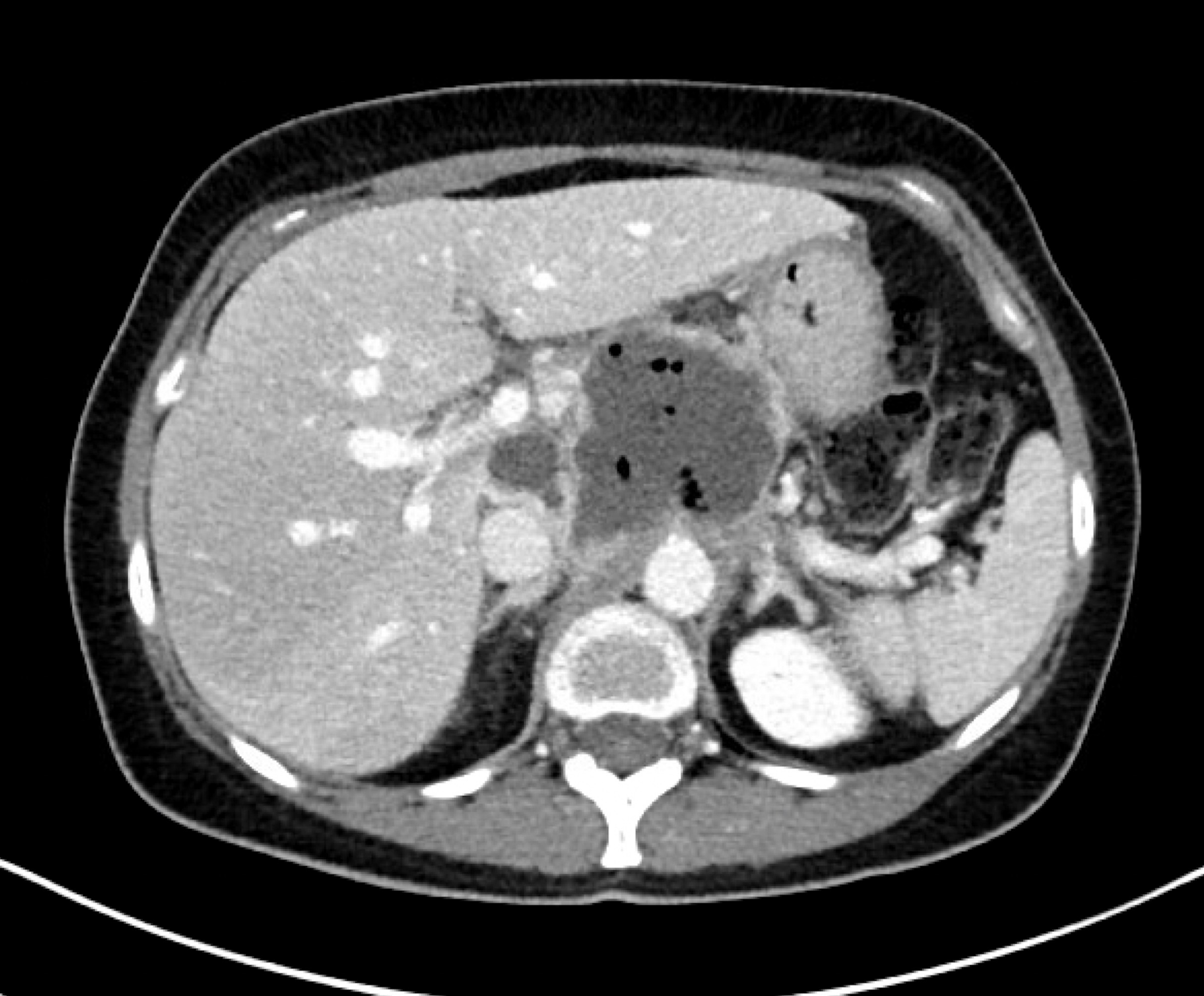Back


Poster Session A - Sunday Afternoon
Category: Biliary/Pancreas
A0067 - A Diagnostically Challenging Case of Primary Pancreatic Lymphoma
Sunday, October 23, 2022
5:00 PM – 7:00 PM ET
Location: Crown Ballroom

Has Audio

Kuntal Bhowmick, MD
Brown University
Providence, RI
Presenting Author(s)
Kuntal Bhowmick, MD, Breton Roussel, MD, Pranith Perera, MD
Brown University, Providence, RI
Introduction: Primary Pancreatic Lymphoma (PPL) is the exceedingly rare instance of extranodal Non-Hodgkin's Lymphoma developing mainly in the pancreas. We report a diagnostically challenging case of a patient presenting with a rapidly growing pancreatic mass, found to have PPL.
Case Description/Methods: A 48-year-old female with past history of tobacco use presented with several months of cramping abdominal pain following COVID-19 infection. She denied weight loss, fevers, or night sweats. Her physical exam, CBC, CMP, lipase, LDH, and CA 19-9 were unremarkable. An abdominal ultrasound revealed a 2.8 x 1.9 x 3 cm cystic mass of the pancreatic head, most congruent with a pseudocyst. Worsening abdominal pain prompted repeat ultrasound one month later, which showed a doubling in size. Endoscopic ultrasound (EUS) with fine needle aspiration of the cystic mass and surrounding lymph nodes yielded cystic contents and reactive lymphadenopathy. Two months later, her abdominal pain worsened and repeat imaging showed further doubling in size with encasement of the celiac plexus. A second FNA performed via EUS redemonstrated cystic contents. An ultrasound-guided core needle biopsy of the mass revealed necrotic CD30+ diffuse large B cell lymphoma (DLBCL). PET scan was suggestive of stage IV PPL. Imaging also identified an inguinal lymph node that returned as CD10+ BCL6+ high grade follicular lymphoma, which was thought to be a distinct lesion. She was started on R-CHOP. Her clinical course was complicated by the formation and subsequent rupture of a splenic artery pseudoaneurysm, gastrointestinal bleeding, anuric kidney injury, and intestinal ischemia. She ultimately transitioned to comfort care.
Discussion: Primary pancreatic lymphoma comprises 0.6% of extranodal lymphomas and 0.2% of primary pancreatic tumors. The clinical presentation is often vague and includes abdominal pain, B symptoms, jaundice, or bowel obstruction. The diagnostic criteria according to the WHO requires that the (1) majority of tumor burden be localized to the pancreas and (2) existing nearby and distant lymph node involvement should be secondary to pancreatic presentation. A biopsy is required to diagnose PPL, which is histologically most often DLBCL. Our case highlights the challenges associated with diagnosing PPL despite two EUS with FNA. Although rare, one should proceed with a high index of suspicion for PPL in any patient presenting with a rapidly enlarging pancreatic mass.

Disclosures:
Kuntal Bhowmick, MD, Breton Roussel, MD, Pranith Perera, MD. A0067 - A Diagnostically Challenging Case of Primary Pancreatic Lymphoma, ACG 2022 Annual Scientific Meeting Abstracts. Charlotte, NC: American College of Gastroenterology.
Brown University, Providence, RI
Introduction: Primary Pancreatic Lymphoma (PPL) is the exceedingly rare instance of extranodal Non-Hodgkin's Lymphoma developing mainly in the pancreas. We report a diagnostically challenging case of a patient presenting with a rapidly growing pancreatic mass, found to have PPL.
Case Description/Methods: A 48-year-old female with past history of tobacco use presented with several months of cramping abdominal pain following COVID-19 infection. She denied weight loss, fevers, or night sweats. Her physical exam, CBC, CMP, lipase, LDH, and CA 19-9 were unremarkable. An abdominal ultrasound revealed a 2.8 x 1.9 x 3 cm cystic mass of the pancreatic head, most congruent with a pseudocyst. Worsening abdominal pain prompted repeat ultrasound one month later, which showed a doubling in size. Endoscopic ultrasound (EUS) with fine needle aspiration of the cystic mass and surrounding lymph nodes yielded cystic contents and reactive lymphadenopathy. Two months later, her abdominal pain worsened and repeat imaging showed further doubling in size with encasement of the celiac plexus. A second FNA performed via EUS redemonstrated cystic contents. An ultrasound-guided core needle biopsy of the mass revealed necrotic CD30+ diffuse large B cell lymphoma (DLBCL). PET scan was suggestive of stage IV PPL. Imaging also identified an inguinal lymph node that returned as CD10+ BCL6+ high grade follicular lymphoma, which was thought to be a distinct lesion. She was started on R-CHOP. Her clinical course was complicated by the formation and subsequent rupture of a splenic artery pseudoaneurysm, gastrointestinal bleeding, anuric kidney injury, and intestinal ischemia. She ultimately transitioned to comfort care.
Discussion: Primary pancreatic lymphoma comprises 0.6% of extranodal lymphomas and 0.2% of primary pancreatic tumors. The clinical presentation is often vague and includes abdominal pain, B symptoms, jaundice, or bowel obstruction. The diagnostic criteria according to the WHO requires that the (1) majority of tumor burden be localized to the pancreas and (2) existing nearby and distant lymph node involvement should be secondary to pancreatic presentation. A biopsy is required to diagnose PPL, which is histologically most often DLBCL. Our case highlights the challenges associated with diagnosing PPL despite two EUS with FNA. Although rare, one should proceed with a high index of suspicion for PPL in any patient presenting with a rapidly enlarging pancreatic mass.

Figure: CT image of necrotic pancreatic mass.
Disclosures:
Kuntal Bhowmick indicated no relevant financial relationships.
Breton Roussel indicated no relevant financial relationships.
Pranith Perera indicated no relevant financial relationships.
Kuntal Bhowmick, MD, Breton Roussel, MD, Pranith Perera, MD. A0067 - A Diagnostically Challenging Case of Primary Pancreatic Lymphoma, ACG 2022 Annual Scientific Meeting Abstracts. Charlotte, NC: American College of Gastroenterology.
